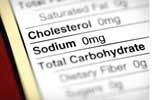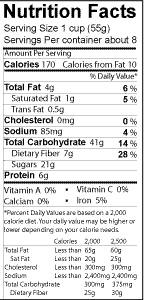
The Food and Drug Administration (FDA) regulates food labeling to assure consumers that the information they receive is accurate and not misleading. Labels contain a lot of useful information to help you compare products and make healthy food choices.
Click on a topic below to find out more.
 The Food and Drug Administration (FDA) regulates food labeling to assure consumers that information is accurate and not misleading. Labels contain useful information to help you make healthier food choices.
The Food and Drug Administration (FDA) regulates food labeling to assure consumers that information is accurate and not misleading. Labels contain useful information to help you make healthier food choices.
Serving Size
Identified in familiar units (such as cups or tablespoons) followed by the metric equivalent (i.e. grams) and is determined by the amount typically eaten.
NOTE: What is “typically eaten” may not be the amount you consume. For example, a 15-ounce can of soup shows 2 servings, but many of us will eat both servings.
Amount per Serving
Nutritional information is based on one serving. If you eat 2 servings you need to double the calories, nutrients and % Daily Value.
Calories from Fat
This is the amount of fat multiplied by 9 (number of calories per gram of fat). Dietary guidelines suggest no more than 30% of daily calories come from fat. To calculate the percentage, divide Calories from Fat by Calories (using the label above, 10 ÷ 170 = 6%).
Nutrients
Values are listed in grams except for Cholesterol and Sodium, which are in milligrams. Use these figures to compare fat, sodium, etc. among products. If a nutrient is not shown, there is no significant amount in the product.
% Daily Value
Listed for several nutrients, this shows how much of the Recommended Daily Values (RDVs) each nutrient provides and is another way to compare similar products. Calculations are based on 2,000 calories. In the label above, the total RDV for sodium is 4% (total daily sodium of 2,400mg divided by sodium per serving of 85mg).
Ingredients
Listed in order from most to least amount. Generally, if sodium is one of the first 3 ingredients, there is probably too much salt for a low-salt diet.
The following descriptions of calories and nutrients are excerpts from the Pocket Guide to Low Sodium Foods. Click on a nutrient to find out more.
Once consumed and digested, food is converted to glucose which fuels everything the body does, like walking, talking, and breathing. The amount of calories needed is different for every individual. For example, the more active an individual, the greater the caloric need. However, when the body takes in more calories than it requires, the extra energy is stored as body fat.
The bad, or low-density lipoproteins (LDL), stick to the blood vessel walls contributing to clogged arteries and hypertension, and is the leading cause for heart disease. The good, or high-density lipoproteins (HDL), unstick LDLs and help move them through the bloodstream and out of the body. This is why the ratio of HDL to LDL is important.
Over time the LDL deposits (along with fat) build up, causing the arteries to clog. As the arteries narrow, the flow of blood decreases and blood pressure increases. This build-up of fatty deposits is also a major factor in coronary disease and strokes.
Research indicates that saturated fats and trans-fatty acids have a greater impact in raising cholesterol than from eating dietary cholesterol. It should be noted, that most foods high in cholesterol are also high in saturated fats, and vice versa.
Cholesterol is found mainly in animal foods (meat, poultry, fish, egg yolks, and dairy products), it is not found in plant foods. The daily recommendation for cholesterol is less than 300mg.
Trans fatty acids, considered saturated and classified as bad, not only raise LDLs, but also decrease HDLs. Many experts believe trans fats are as bad as, if not worse than, saturated fats.
Saturated — Usually solid at room temperature (comes mainly from animal products, such as butter, cheese, meat products, egg yolks, and whole milk dairy products).
Monounsaturated — Liquid at room temperature, but solidifies in the refrigerator (found in plant foods, such as olive oil, canola oil, avocados, and nuts.
Polyunsaturated — Liquid at room temperature and also in the refrigerator (examples are vegetable oils, including corn oil, safflower oil, and sunflower oil).
Trans fatty acids — Result of hydrogenation and used for shelf stability or solidifying a fat product (found in margarine, crackers, cookies, potato chips, and fast foods, such as french fries).If a product lists hydrogenated or partially hydrogenated in the ingredients, it has trans-fatty acids. Be aware that many low-fat, low-cholesterol products may have trans fats.
The American Heart Association (AHA) suggests no more than 30% of total calories come from fat and no more than 10% from saturated fat (7% if you have heart disease, diabetes, or high LDL cholesterol). As a general rule, any food that has 5% or less fat is considered low in fat; 20% or more, is high. Choose fats with 2g or less saturated fat per serving.
Simple carbohydrates — generally have no nutritive value and produce a rapid rise in blood glucose followed by a rapid fall.
Complex carbohydrates — are more nutritious and produce a slower, more sustained blood glucose response. Foods high in complex carbohydrates are usually low in calories, saturated fat, and cholesterol. They are found primarily in plant foods, such as fruits, vegetables, whole grains, beans, and legumes. They also are present in dairy products.
Daily caloric intake of carbohydrates should be between 55-60% (or 25-35 grams) with an emphasis on complex carbohydrates.
Soluble fiber — dissolves in fluids of the large intestine. Soluble fiber is found in oats, barley, rye, nuts, fruits, vegetables, psyllium seeds (used in fiber laxatives), beans, and legumes. Consumed in large amounts, soluble fiber can decrease blood cholesterol, improve blood glucose levels, and appears to reduce hypertension. It also may help with weight loss by increasing the feeling of fullness.
Insoluble fiber — instead of dissolving, it passes straight through the intestines and helps maintain regularity. It is found in whole grains, seeds, bran, fruit and vegetable skins. It also is associated with reduced risk of colon cancer.
The amount of fiber also affects blood glucose. The more fiber in a food, the slower the digestion and absorption of sugars. To help understand fiber’s influence on blood glucose, the glycemic index (GI) was developed. Using glucose (the highest rated GI) as a standard, a food is ranked by how fast it is digested and how much it causes blood glucose to rise.\
The recommended level of total insoluble and soluble fiber is 20-35 grams per day. Look for a minimum of 3 grams of fiber per serving, but 5 grams or more is better.
Current research indicates long-term consumption of a diet high in refined (simple) carbohydrates produces higher insulin levels. As insulin levels elevate, adrenaline production is stimulated, which can cause blood vessel constriction and increased sodium retention. Additionally, high carbohydrate intake has been linked to increased LDL and decreased HDL cholesterol.
Even though the RDVs have no sugar guidelines, the US Dept. of Agriculture (USDA) advises limiting sugar to 10 teaspoons (47g) a day (based on a 2,000-calorie diet).
Select foods that contain less than 5% of the daily value (DV) for sodium (120mg) per serving. Limit any food that has more than 480 mg (20% DV).
The FDA has provided guidelines for claims and descriptions manufacturers may use on food labeling. Based on one serving, they include:
| Free | Low | Reduced/Less | Light/Lite | |
|---|---|---|---|---|
| Calories | < 5 calories | 40 calories or less | 25% less than normal | 1/3 fewer calories |
| Fat | < 0.5g fat | 3g or less fat | 25% less than normal | 50% less than normal |
| Saturated fat |
< 0.5g sat fat & < 0.5g trans fatty acids | 1g or less sat fat | 25% less than normal | 50% less than normal |
| Cholesterol | < 2mg chol & 2g or less sat fat | < 20mg chol & 2g or less sat fat | 25% less than normal | 50% less than normal |
| Sugar | < 0.5g sugar | 25% less than normal | 50% less than normal | |
| Free | Very low | Low | Unsalted/NSA | |
| Sodium | < 5mg | < 35mg | < 140mg | No salt added to normally salted food |

Recent Comments